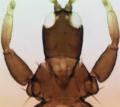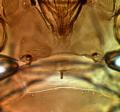Liothrips xanthocerus
Recognition data
Distinguishing features
Both sexes fully winged. Body and legs, including mid and hind tarsi, blackish brown, fore tarsi paler, antennal segments III–VI and basal half of VII yellow; major setae black and bluntly pointed; fore wing deeply shaded, paler distally. Head longer than wide; maxillary stylets retracted to eyes, close together medially; post ocular setae varying from shorter to longer than dorsal length of eyes; mouth cone extending between fore coxae. Antennae 8-segmented; segment III with one sensorium, IV with three sensoria; VIII slender and slightly constricted at base. Pronotum with five pairs of long major setae; epimeral sutures complete; prosternal basantra not developed, ferna present, mesopresternum very slender medially between lateral triangles. Fore tarsus without a tooth. Metanotum with elongate narrow reticulation, median setae stout. Fore wing parallel sided, without duplicated cilia; three sub-basal setae sub-equal in length. Tergite IX setae S1 pointed, slightly shorter than tube.
Male similar to female; tergite IX setae S2 apparently variable, but shorter than S1 and sometimes stouter; sternite VIII with a broadly extensive pore plate.
Related and similar species
L. xanthocerus is distinctive amongst the Californian species, not only in lacking duplicated cilia on the fore wings, but also in the curiously pale antennae despite the dark body, legs and major setae. Currently, there are 290 species listed in the genus Liothrips, although 30 of these are placed in two sub-genera known only from Asia. As a result, this is larger than either Thrips or Haplothrips, these three being the largest genera of Thysanoptera. However, in comparison to both Thrips and Haplothrips there are far greater problems in Liothrips in species recognition. A particularly high proportion of the described species are known from single samples, or even single individuals, resulting in little knowledge of variation within and between species, and thus the general assumption that most members of the genus are host-specific requires extensive testing. Stannard (1957) listed 32 species of Liothrips from North America, and subsequently (Stannard, 1968) included 14 of these in his keys to the Illinois fauna. Cott (1957) treated 11 species from California, two of which he placed in Rhynchothrips, but currently from this State there are 13 Liothrips species listed (Hoddle et al., 2004) of which several cannot at present be recognized.
Taxonomic data
Current valid name
Liothrips xanthocerus Hood
Original name and synonyms
- Liothrips xanthocerus Hood, 1927: 203
Family placement
Phlaeothripidae, Phlaeothripinae
Biological data
Life history
Unknown
Host plants
Adults have been taken from various plants. However, in the Ewart Collection, Riverside, there are series of both sexes collected from Pluchea sericea (Asteraceae) in Inyo and Riverside Counties.
Tospoviruses vectored
None
Crop damage
None
Distribution data
Area of origin
Western USA
Distribution
Arizona, California, Mexico.








